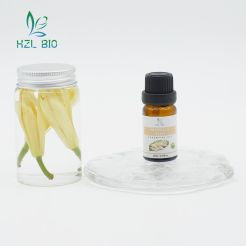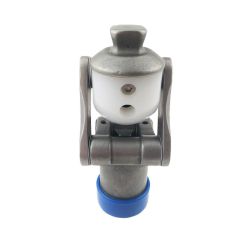Isomaltooligosaccharide Powder - Natural Sweetener
<p>CAS: 499-40-1</p> <p>Product features: Low molecular weight, non viscous, water-soluble</p> <p>Valid Substance Content:90%</p> <p>Grade:Food grade</p> <p>Appearance:White powder</p> <p>Usage: Sweetener</p> <p>Storage: store in cool and dry place</p> <p>Production capacity: 1000 tons/year</p>
Product Description
Isomaltooligosaccharide Powder

In nature, Isomaltooligosaccharide is rarely present in a free state, but as a component of branched starch or polysaccharides, it is present in small amounts in certain fermented foods such as soy sauce, yellow wine, or enzymatic glucose syrup. In industry, the production of isomaltooligosaccharides from starch requires an enzyme called alpha glucosidase, also known as glucosyltransferase or alpha glycosidase. It can cleave the α -1,6 glycosidic bonds in the molecular structures of maltose and maltooligosaccharides, and transfer a free glucose residue to the α -1,6 position in another glucose molecule or maltose or maltotriose, forming isomaltose, isomaltotriose, isomaltetraose, isomaltpentaose, and panose. Low molecular weight isomaltose vibrating screen, low molecular weight isomaltose screening powder machine.
Characteristics:
Maltose is a disaccharide formed by connecting two glucose molecules with alpha 1,4 glycosidic bonds, while isomaltose is a disaccharide formed by connecting two glucose molecules with alpha 1,6 glycosidic bonds. Due to different molecular conformations, it is called isomaltose to distinguish it from maltose. Usually, maltose is easily fermented by yeast, while isomaltose is not fermented by yeast. Isomaltose is a non fermentative oligosaccharide.
Oligosaccharide isomaltose can effectively promote the growth and reproduction of beneficial bacteria in the human body - Bifidobacterium, so it is also known as "Bifidobacterium growth promoting factor", abbreviated as "Bifidobacterium factor". Syrup is a colorless or light yellow, transparent, viscous liquid with a soft sweet taste, no odor, and no visible impurities; Sugar powder is an amorphous powder with a soft sweet taste, no odor, and no visible impurities. It dissolves in warm water and becomes colorless or light yellow. After years of clinical and practical application, it has been shown that Bifidobacterium has many health functions, and oligomeric isomaltose, as a promoting factor of Bifidobacterium, has naturally attracted people's attention.
The properties of oligomeric isomaltose are introduced as follows:
1.Sweetness
Comparing the sweetness of oligomeric isomaltose and its sugars with a sweetness of 100% in white sugar (at 20 ℃, compared to a 10% sucrose solution):
| Type | Sweetness |
| White Sugar | 100 |
| High fructose syrup | 165 |
| Glucose | 70 |
| Maltose | 40 |
| Sorbitol | 65 |
| Oligomeric Isomaltose Syrup1MO-500 | 52 |
| Oligomeric Isomaltose Syrup 1MO-900 | 42 |
| High maltose syrup | 40 |
Oligomeric isomaltose syrup (powder) has a good taste and can be used to replace some sucrose, improve food taste, and reduce sweetness.
2.Viscosity
Oligomeric isomaltose syrup has a viscosity similar to that of sucrose solution at the same concentration, making it easier to process than maltose. It has no adverse effects on the tissue and characteristics of foods such as candies and pastries.
3.Heat resistance and acid resistance
Isomaltooligosaccharides have excellent heat and acid resistance. 50% concentration syrup will not decompose when heated for a long time at pH 3 and 120 ℃. Applied to beverages, canned goods, high-temperature treatments or low pH foods, it can maintain its original characteristics and functions.
4.Moisturizing Properties
Isomaltooligosaccharides have moisturizing properties, making it difficult for water to evaporate. They have a good effect on moisturizing various foods and maintaining their quality, and can inhibit the crystallization of sucrose and glucose. Breads, desserts and other starch based foods tend to harden after a little storage, while adding isomaltooligosaccharides can prevent starch aging and extend the storage time of foods.
5.Colorability
The end of the sugar molecule contained in isomaltooligosaccharides is a reducing gene. When co heated with proteins or amino acids, Maillard reactions occur, resulting in chromogenic changes. The degree of coloring is related to the sugar concentration and the type of protein or amino acid co heated, pH, heating temperature, and duration. Therefore, when using oligomeric isomaltose to process various foods, the combination of the above factors should be considered.
6.Water activity
Water activity of oligomeric isomaltose: 0.75 at a concentration of 75% and 25 ℃. Approaching sucrose, it is quite convenient to convert it into food formulas as a substitute for some sucrose.
7.Freezing point drop
The freezing point of isomaltooligosaccharides decreases similar to sucrose, and the freezing temperature is higher than fructose. Used in the manufacturing of cold drinks to make the product soft and delicious.
8.Fermentability
Isomaltooligosaccharides are sugars that cannot be utilized by yeast and lactic acid bacteria. Added to bread and fermented milk (yogurt), it will not be utilized by yeast or lactic acid bacteria and will remain in food to exert its characteristics and promote the development of bifidobacteria. Especially in fermented milk, it will not hinder normal lactic acid bacteria fermentation.
9.Anti caries properties
Oligosaccharide isomaltose has excellent anti caries properties and is not easily fermented by the tooth decay pathogen Streptococcus mutants. Therefore, it produces less acid and is less prone to tooth corrosion. When used in combination with sucrose, it can also hinder the production of water-soluble high molecular weight glucan from sucrose, which is less susceptible to the action of Streptococcus mutants, and inhibit the tooth decay of sucrose. Panose in oligomeric isomaltose has a significant effect on inhibiting the formation of dental plaque.
Dental caries is also one of the most common dental diseases among children in China. Protecting children's oral hygiene and preventing dental diseases, replacing white sugar with oligomeric isomaltose, and producing food and beverages that are not prone to dental caries is a valuable work, hoping to attract the attention of the health and food health sectors.
10.Security
The maximum ineffective dose of isomaltooligosaccharides is above 2g/kg body weight. For oligomeric isomaltose powder, oral administration to mice with acute toxicity LD50 of 4g/kg body weight or above is extremely safe compared to low toxicity sucrose (LD50 of 29.8/kg body weight) and maltose (LD50 of 26.7/kg body weight).
Adding the above sugar powder to drinking water, the mice can freely consume it within one year, with a daily intake of 2.7-5.0 g/kg of isomaltose body weight. After long-term feeding experiments, anatomical results and blood tests showed no abnormal phenomena. Bacterial regression mutation tests and chromosomal abnormality tests on cultured cells showed no mutagenicity. So, isomaltooligosaccharides are highly safe sweeteners.
Specifications:
| Product Name | isomaltooligosaccharide/imo/isomalto-oligosaccharide |
| CAS | 499-40-1 |
| Valid Substance Content | 90% |
| Product features | Low molecular weight, non viscous, water-soluble |
| Grade | Food Grade |
| Appearance | White powder |
| Storage | Be stored in cool and dry place. |
| Function | Sweetener |
Basic Usage:
A low calorie water chestnut fiber nutritional tablet and its preparation process, using low calorie water chestnut fiber powder as raw material, supplemented with oligofructose and isomaltooligosaccharides as sweeteners, and mixed with skim and sugar free milk powder to prepare. The preparation process of the present invention includes: wet residue of fresh water chestnuts, cleaning and impurity removal, centrifugal filtration, rinsing, crushing, centrifugal filtration, high-pressure and high-temperature steaming and softening, crushing, drying, crushing, screening, water chestnuts fiber powder, mixing and blending, tablet pressing, and packaging. During the softening process mentioned above, the pressure is between 0.1 and 0.3 Mpa, and the temperature is between 120 ℃ and 150 ℃. The low calorie water chestnut fiber nutritional tablet of the present invention belongs to the category of high fiber, low fat, low sugar, and high protein content foods, which can maximize the satisfaction of those who love sweets but are worried about gaining weight. It is also suitable as a food for patients with hypertension, hyperlipidemia, hyperglycemia, coronary heart disease, constipation, dental caries, and middle-aged and elderly people
Oligomeric isomaltose has many excellent properties and health physiological functions mentioned above, and is suitable to replace some sucrose and add to various beverages and foods, such as:
Beverages: carbonated drinks, soy milk drinks, fruit juice drinks, vegetable juice drinks, tea drinks, nutritional drinks, iron supplements, calcium supplements, iodine supplements, alcoholic beverages, coffee, cocoa, powder drinks, etc.
Dairy products: milk, seasoned milk, fermented milk, lactobacillus drinks, and various types of milk powder.
Candy Cakes: Various soft candies, hard candies, sorghum malt, brown candies, chocolates, various biscuits, various pastries, lamb soup, mooncakes, tangtuan fillings, and various cake fillings.
Sweet Dim sum: pudding, gel food, etc
Cold drinks: various types of ice cream, popsicles, ice cream, etc.
Baked foods: bread, cake, etc.
In addition, it can also be used as an ingredient in processed animal meat, aquatic products, fruit sauce, honey processed products, etc.
Intake:
Isomaltooligosaccharides can be added to various foods or consumed directly. Because some foods add oligosaccharides of isomaltose just to seek a selling point, they exaggerate when added in small amounts or not at all, leading to consumers mistakenly believing that the effect of oligosaccharides of isomaltose is not significant. Practice has proven that the effect of isomaltooligosaccharides is very significant, and the most convenient, effective, and easy to control method is direct consumption. When consumed directly, it can be rinsed with water or added to food such as porridge. The effective dosage is as follows:
IMO-900: Calculated based on an adult weight of 60 kilograms, the daily intake is about 10 grams (one full spoon): for infants and young children, it is 0.17 grams per kilogram of body weight.
Manufacturing Process:
Although isomaltooligosaccharides have no side effects on the human body, they can cause some adverse reactions when taken together with certain medications, leading to stomach discomfort. Therefore, it is best to have a 2-hour interval between taking medication and isomaltooligosaccharides. On the other hand, isomaltooligosaccharides belong to non fermentable sugars, and when taken together with drugs, they can hinder the absorption of drugs by the human body and reduce their efficacy.
There are generally two ways to produce isomaltooligosaccharides: ① using the reverse reaction of glycosylase to produce isomaltose, maltose, and other oligosaccharides in high concentration glucose solution. However, the IMO produced by this method has the disadvantages of low yield, complex product, and long production cycle, making it difficult to industrialize and widely promote; ② High concentration glucose syrup made from starch is used as a substrate and catalyzed by a-glucosyltransferase. Obtained through glucose transfer reaction. The industrial production of isomaltooligosaccharides generally uses starch as the raw material and adopts the whole enzyme process.
Starch —— spray liquefaction —— β - amylase saccharification —— α - glucosyltransferase conversion —— decolorization —— ion exchange —— vacuum concentration or spray drying —— a finished product.
Process Control:
Mastering jet liquefaction technology is a prerequisite for production.
Due to the fact that oligomers of isomaltose are mainly composed of isomaltose, panose, isomaltotriose, isomaltetraose, etc. bound to a-1,6 glycosidic bonds, accounting for more than 50% of the total sugar, and the glucose content should be controlled as much as possible, the process conditions of continuous jet liquefaction should be strictly controlled to achieve complete gelatinization and control the degree of starch hydrolysis (lower DE value).
Concentration determination:
The concentration of starch milk directly affects the liquefaction operation and indirectly affects the degree of saccharification. Practice has shown that the concentration of starch milk is lower, the liquefaction operation is easy to master, and the liquefaction is uniform and complete, with good results.
Enzyme Selection:
The high temperature generated by steam spraying of starch solution promotes the rapid gelatinization of starch, and with the strong hydrolysis effect of amylase, the fully gelatinized starch is completely liquefied. At this point, the gelatinization rate of starch is synchronized with the liquefaction rate, rapidly degrading starch into dextrin and a small amount of oligosaccharides, and the viscosity decreases, exhibiting water flow, allowing for smooth liquefaction.
Influence on the values:
Taking into account enzyme activity, preventing starch aging, and ensuring the quality of liquefied liquid, the optimal pH value is selected between 6.2-6.4. If pH<6.0, the enzyme activity significantly decreases, and the liquefied liquid is prone to aging under acidic conditions; If pH>6.5, it will cause isomerization of the reducing terminal glucose residue of oligosaccharides to generate unwanted other sugars.
Liquefaction Control:
In theory, requiring a low DE value is beneficial for generating more oligomeric isomaltose and less glucose. However, practical production experience has shown that it is necessary to control lower DE values and not blindly pursue too low DE values. Using corn starch as raw material and selecting high temperature resistance. The optimal range for controlling the DE value of one amylase injection liquefaction is between 12-15.
Production key:
The saccharification process refers to the production of maltose and maltooligosaccharides from dextrin in a liquefied liquid through the action of saccharifying enzymes. The glycosylation process refers to the conversion of maltose or maltooligosaccharides bound with a-1,4 glycosidic bonds into isomaltose, panose, isomaltotriose, isomaltetraose, etc. bound with a-1,6 glycosidic bonds through the action of glucose glycosidase. In the large-scale production process of oligomeric isomaltose syrup, the saccharification process and glycosylation process are carried out simultaneously in the same tank, so they are collectively referred to as the saccharification glycosylation process.
Purification Separation:
The higher the purity of isomaltooligosaccharides, the better their health benefits. The greater the product value, so it is necessary to separate glucose and maltose from them. Most of the existing research processes in China use yeast to achieve the consumption of glucose and maltose (equivalent to impurity removal), so the requirement for yeast strains is to not or less utilize oligomeric isomaltose. The yeast used in existing processes is generally screened for characteristics and genetically modified. Therefore, it is recommended to conduct traditional strain screening while trying out existing products. There are also methods that use strong acidic cation exchange resin columns for separation and the synergistic effect of glucose oxidase and catalase to remove glucose from the product. There are also methods such as crystallization, organic solvent precipitation, activated carbon adsorption, and nano membrane separation. It can be seen that there are certain difficulties and high costs in achieving impurity removal of oligomeric isomaltose. Most foreign countries have adopted chromatographic separation technology, which has higher purity and better taste.
Application Area:
Isomaltooligosaccharides are mostly used in infant products to produce prebiotic glucose, milk powder, Rice noodles and other products.
OEM&ODM Compound Sweetener:
We are a professional manufacturer of natural sweeteners. In addition to supplying regular Isomaltooligosaccharide Powder specifications, we can also provide you with the best sweetener solution according to your needs. At the same time, we can also provide composite and alternative sugar solutions based on your formula.
Certificates:
Package:
 |
 |
 |
|
5 Grams to 2kg Packaging: Alu-bag |
5 KG/Al-Tin Packaging: 2 pcs Alu-tin with box |
25 KG, Packaging: Drum (54*37*37cm)=0.07CBM N.W:25KG / G.W:28KG |
Delivery:

Why Choose Us

Email: sales@greenspringbio.com
Tel.: +86 132 2777 5215
Fax: +86-29-88328052
Whatsapp: +8613227775215
Add.: China Office Add: Floor 14 Suite B, HuiXin IBC, No.1 Zhang Ba 1 Road, Hi-tech Development Zone, Xi'an. China.
Add.: France Office Add: 149 Avenue DU MAINE 75014 PARIS 14 Phone: +33 659468007











